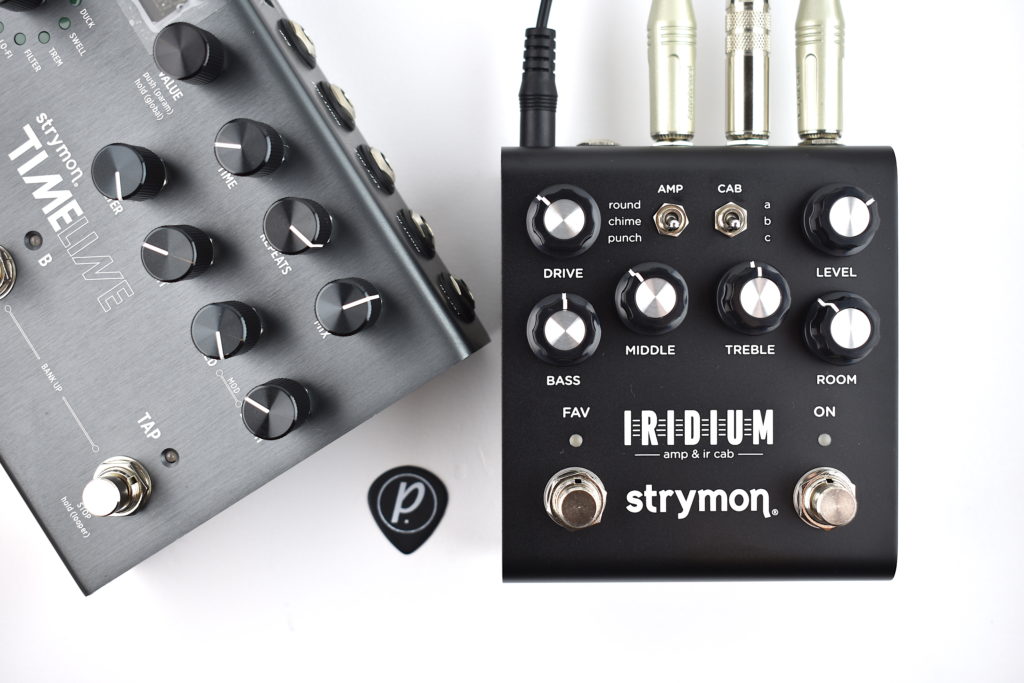The world of Strymon is a fascinating, intriguing and exciting place to be – anyone who’s ever used one of their pedals can certainly attest to that. For their latest release, they’ve gone in a bit of a different direction, but one that is most welcome, and will flip the way pedalboards are arranged and used from this point forward. Iridium is an amplifier and Impulse Response cabinet simulator, one that connects directly to your DAW, mixer or other interface, and provides world-class tube amp sound paired with a perfectly matched speaker cabinet. You can even control the amount of room ambience to make it sound and feel like you’re either in a recording studio OR a live setting. Lots to check out with this one, let’s dig in!
First off, let’s be clear: Iridium is meant to be used to connect to recording interfaces and house PA systems, NOT to your existing amplifier. The use of Strymon’s Matrix Modeling™ process captures all the subtleties and unique character of each amplifier, from the unique composition of each tone stack, to component values, bias levels, corner frequencies, and tube stage gain. Three modes in the AMP section provide you with three iconic tube amplifiers, giving you the response, feel, and inspiring experience of playing through the originals. Round Amp is based on the Fender® Deluxe Reverb: clean, bright, and mid-scooped, with plenty of headroom. Chime Amp emulates the Brilliant channel (Top Boost) of the classic Vox® AC30, and is jangly, bright, and chimey, providing air for subtle passages with a light touch, and bite when you want to dig in. Punch Amp is based on the Marshall® Plexi Super Lead, a meatier, higher gain amp with a powerful midrange response, distortion and growl.
The CAB section provides NINE different cabinets to pair to these classic amps, a carefully curated collection of premium cabinet impulse responses from OwnHammer, Celestion, cabIR and ValhallaIR. These cabs include:
Round A – impulse captures a vintage Fender Deluxe Reverb open back 1×12” combo loaded with a 1978 Fender CTS ceramic 12” speaker
Round B – impulse captures a 1×12” Blues Junior cabinet, loaded with a Jensen C12N speaker
Round C – impulse captures a Fender Vibrolux from 1965 with 2×10” Jensen C10NS speakers from 1965
Chime A – impulse captures a Vox AC30/6 open back fawn 2×12” combo with 2001 Celestion T0530 Blue AlNiCo speakers
Chime B – impulse captures Celestion Blue Alnico speaker in a closed back 1×12” cab
Chime C – impulse captures a 4×12” Mesa Boogie “Halfback”, which is loaded (open back) with two Black Shadow MC-90 speakers from Celestion and two Black Shadow EVM12-L from ElectroVoice
Punch A – impulse captures a 1971 Marshall 1960B “basketweave” 4×12” cabinet
Punch B – impulse captures a Celestion Vintage 30 in an open back 2×12” cab
Punch C – impulse captures a re-issue of the 1965 Marshall 8×12” full stack cabinet, loaded with Celestion T652 AlNiCo speakers
Iridium delivers full stereo 24bit 96kHz resolution for the entire 500 milliseconds of its speaker cabinet impulse responses, previously only available for use within studio recording software. This breakthrough technology means you can use the very best impulse responses available, bringing maximum realism to your pedalboard. The result is stunningly realistic cabinet tones, and with all these cab options plus the three iconic amps, the possibilities are endless.
Once you’ve got your amp and cab picked out, it’s time for some tweaking. Drive adjusts the amount of gain applied, with the character and response of the Drive setting being different for each amp type. Level controls the output volume for both left and right outputs, as well as the headphone output (more on that in a minute). Bass adjusts the tone stack of the selected amp type to highlight the low frequencies. Middle adjusts the tone stack of the Round and Punch amp types to highlight the middle frequencies, and rolls off high frequencies as the knob is turned up for the Chime amp type. Treble adjusts the tone stack of the selected amp type to highlight the high frequencies. Finally, Room controls the level of natural room ambience, with a Secondary function (it is a Strymon pedal, you know) allowing you to toggle between three room sizes (small, medium, large). There’s a Secondary function for the Level knob as well, Level Trim, which temporarily scales the output level for headphone use.
Iridium also features Stereo Outputs, an Expression/MIDI jack for Volume Pedal and MIDI automation, a USB jack to load your own IR files via your computer and an Audio Input Selector. With this, you can choose Mono, Stereo or Sum, for a stereo input that is summed to mono and sent out the left output jack. The ultra low noise, discrete, class-A JFET preamp circuit provides up to 20dB of an analog, variable gain JFET circuit, used in concert with DSP to create the tube driven input stage of each of Iridium’s amps. There’s even a Headphone jack, which allows you to get immersed in the sounds of these iconic amps and cabs in a natural sounding room, without disturbing your family, neighbors or anyone at your workplace (if you can get away with that).
Don’t forget the classic FAV button, which allows you to store your favorite settings for quick and easy access (the MultiSwitchPlus lets you choose from 4 presets as well). Painstakingly researching things like treble bleed on the gain controls, multi-stage power supply sag, and preamp and power amp tube emulation, the crew at Strymon used every available resource with Iridium to recreate these classic amp designs with exact mathematical fidelity, and then went a bit further by expanding the capabilities of each amp in musically useful ways. Modeling the compression, limited cone movement, and speaker distortion that can happen at high signal levels, they carefully set the range and taper for each knob to make it easy to dial in a variety of great tones with intuitive, predictable amp-like responsiveness. We love this thing, and have put together a little demo below for your viewing pleasure, to see and hear Iridium in all its glory. Cheers to Strymon for taking yet another fantastic leap forward, and for creating a pedalboard-friendly tone machine that is as easy to use as it is incredible-sounding.
GET EXCLUSIVE UPDATES, CONTEST INFO, SEE OUR LATEST DEMO VIDEOS AND MORE:
















